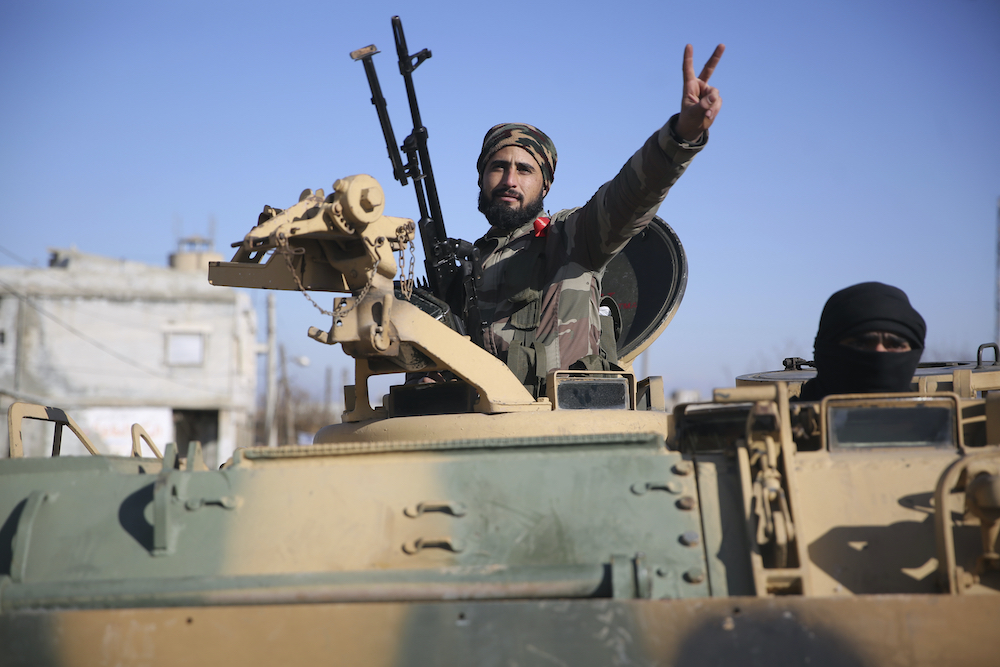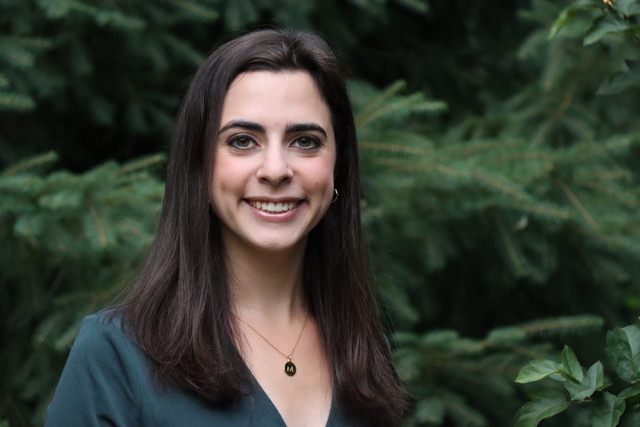
Turkish-backed Syrian fighters in February 2020 mobilize in the village of al-Mastumah for military action against the Syrian regime after the escalation by the Syrian regime in Idlib governorate
“They say [the] Vietnam War was the first television war,” said BBC chief international correspondent Lyse Doucet. “Syria was the first social media war.”
Against the backdrop of the Arab Spring, Syria’s peaceful uprisings devolved into a bloody, multidimensional conflict that recently entered its ninth year. Hundreds of thousands of people are dead and about 12 million are displaced, in what the United Nations human rights chief called the “worst man-made disaster the world has seen since World War II.”
Foreign reporters faced a unique set of dilemmas when reporting on the war in Syria. The country’s inaccessibility — due to government control and danger — led Western media outlets to rely more heavily on Syrian citizen journalists and media activists who documented protests and violence, often by uploading videos to social media. This reliance led to verification challenges as well as moral and ethical dilemmas.
Assad’s regime made the country especially inaccessible for journalists, and extremist groups that took root in power vacuums posed safety threats. ISIS was known for beheading victims, including journalists Steven Sotloff and James Foley, and posting videos of executions online.
The line between labeling Syrians with no formal background in journalism who documented events and posted them on social media platforms — “citizen journalists,” “media activists,” and “opposition journalists” — can be blurry. When citizen journalists band together to form an opposition media network, are they no longer considered citizen journalists? How should their title change when an organization of citizen journalists receives outside funding from a journalism or pro-democracy organization? If someone disseminates their video through a local committee, should the person’s label be “activist,” “citizen journalist” or something else entirely? If a civilian graduates from filming protests on a cellphone to an industry-standard camera and receives funding or payments, are they still citizen journalists, or do they become freelancers?
“The label of citizen journalism has been given to them by us, not by them. So what we were doing was reaching out to people who weren’t journalists, but were on the other side. And some of those people were activists,” said Liz Sly, the Beirut bureau chief for The Washington Post. “I identified them as activists in my reports. They are people who picked up video cameras, picked up their cell phones, started recording what was going on because they knew it wouldn’t be in the official state media. And they wanted the world to know what was happening. So in a way that made them journalist-like, but they were never formal journalists, and they’re still not.”
Although Western media companies use a variety of stringent verification measures to vet videos coming out of Syria that were not taken by their own journalists, these processes were not always foolproof.
In October 2019, ABC News ran a video on “World News Tonight” and “Good Morning America” that was reportedly filmed on the Syrian border. “This video right here appearing to show Turkey’s military bombing [Kurdish] civilians in a Syrian border town,” the ABC reporter says of a video depicting fiery explosions. The only problem? The clip was strikingly similar to a video taken at a Kentucky gun range. ABC News later issued a correction.
Another layer of the ethical dilemma of using citizen journalists’ footage or photos is the question of unintentionally creating an incentive for civilians to put themselves in harm’s way.
According to the Committee to Protect Journalists (CPJ), 137 journalists have been killed in Syria since 2011. Of those 137, 123 were local. These journalists were not all citizen journalists or media activists; some worked for regional organizations or Syrian state-run outlets, but the statistics demonstrate the high risk for local journalists. The Syrian Network for Human Rights (SNHR) in a May 2020 report put the number of citizen journalists killed during the conflict at 707.
“For the journalists who are Syrian citizen journalists, I think the risks are much higher,” CNN’s Clarissa Ward said when describing the risks of reporting inside Syria for Western journalists versus Syrian citizen journalists. “They don’t have the training; they don’t have the body armor. They don’t have the resources and huge companies backing them. And they’re Syrian, so they can just disappear one day, whereas that happened as well to Western journalists, but it creates much more of [an] international brouhaha than it does if a Syrian journalist disappears, which sadly, is happening all the time for like nine years, ten years, and frankly, even before then.”
The ethical dilemmas for Western journalists reporting on Syria changed — again — with the rise of the Islamic State in Iraq and Syria (ISIS). There was a degree of citizen journalism that took place in ISIS-controlled areas, such as Raqqa is Being Slaughtered Silently (RBSS), but the risks for citizen journalists were extraordinarily high. ISIS killed multiple people who worked for RBSS or were suspected of working with RBSS.
The extent to which the American-led coalition’s bombing campaigns against ISIS territory injured and killed civilians was largely communicated to the world by citizen journalists, Luke Mogelson, a contributor to The New Yorker, explains.
“I knew that these strikes were killing a lot of people…thanks to journalists like Mosul Eye and Raqqa is Being [Slaughtered Silently],” Mogelson said. Information from those organizations guided his interviews with American commanders, he explained.
Although many journalists emphasized the importance of citizen journalism in communicating information to the world, they also stressed the importance of reporters being on the ground themselves.
For some Western journalists, once they were inside Syria, the ways they used citizen journalism shifted. Citizen journalists may act as guides and work to keep foreign reporters safe.
“They were bringing me to protests. They were bringing me to funerals,” Ward said. “And so I needed them, because it was all completely clandestine, this uprising at that stage. So there was no way to get anywhere near it unless you had some people who were part of this underground movement who were willing to sort of stick their head above the parapet and take the risk to help you out.”
“Yes, they told us about the humanitarian hardship. Yes, they told us about the damage of the bombardment. All of that was true,” Doucet said. “But they didn’t tell the full story because they couldn’t, because their own lives would have been at risk.”
In areas controlled by the government, citizen journalists could be disappeared, tortured, or killed. In areas controlled by ISIS, they could be executed. In active combat zones, they could die in bombings or crossfire. With such a clear danger, why did so many civilians risk their lives to document the uprisings and subsequent civil war?
Syrians believed that if they showed people what was happening, the world would come to their aid, multiple Western journalists explained.
When examining the context of Syria’s uprising and civil war, Syrians’ hopes of international intervention against the regime do not appear to be unrealistic. In 2011, the U.S. and other NATO countries intervened against Qaddafi in Libya, and in August 2011, President Barack Obama called for Assad to step down. In August 2012, Obama also issued a “red line” against the use of chemical weapons in Syria.
Reporting on Syria’s civil war was one of the first times Western media outlets had to grapple with verification and ethical questions that arise from using citizen journalism during wartime, but it certainly will not be the last.
Read Megan Lebowitz’s full report, “Reporting the First Social Media War,” here.

